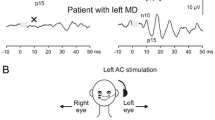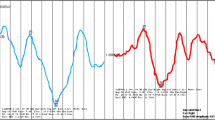Abstract
Vestibular-evoked myogenic potential (VEMP) recording is a new tool for exploring the pathways from the sacculus, inferior vestibular nerve, and vestibular nucleus to sternocleidomastoid muscles (SCMs) in pediatric otology and neurotology. c-VEMP (saccular origin) and o-VEMP (utriculus origin) are clinically applied for a different diagnosis. After cochlear implantion, c-VEMPs are possible to record because of an electrical current spread from cochlear nerve which stimulates the inferior vestibular nerve.
Access this chapter
Tax calculation will be finalised at checkout
Purchases are for personal use only
Similar content being viewed by others
References
Sheykholeslami K, Megerian CA, Arnold JE, Kaga K. Vestibular-evoked myogenic potentials in infancy and early childhood. Laryngoscope. 2005;115:1440–4. doi:10.1097/01.mlg.0000167976.58724.22.
Kaga K. Development of balance and motor function achieved by central vestibular compensation. Adv Neurol Sci. 2005;49:216–28.
Colebatch JG, Halmagyi GM, Skuse NF. Myogenic potentials generated by a click-evoked vestibulocollic reflex. J Neurol Neurosurg Psychiatry. 1994;57:190–7. doi:10.1136/jnnp.57.2.190.
Sheykholeslami K, Kaga. The otolithic organ as a receptor of vestibular hearing revealed by vestibular-evoked myogenic potentials in patients with inner ear anomalies. Hear Res. 2002;165:62–7. doi:10.1016/S0378-5955(02)00278-2.
Sheykholeslami K, Habiby Kermany M, Kaga K. Frequency sensitivity range of the saccule to bone-conducted stimuli measured by vestibular evoked myogenic potentials. Hear Res. 2001;160:58–62. doi:10.1016/S0378-5995(01)00333-1.
Watson SRD, Colebatch JG. Vestibulocollic reflexes evoked by short-duration galvanic stimulation in man. J Physiol. 1998;513:587–97. doi:10.1111/j.1469-7793.1998.587bb.x.
Sheykholeslami K, Habiby Kermany M, Kaga K. Bone-conducted vestibular evoked myogenic potentials in patients with congenital atresia of the external auditory canal. Int J Pediatr Otorhinolaryngol. 2001;57:25–9. doi:10.1016/S0165-5876(00)00430-4.
Shinjo Y, Jin Y, Kaga K. Assessment of vestibular function of infants and children with congenital and acquired deafness using the ice-water caloric test, rotation chair test and vestibular-evoked myogenic potential recording. Acta Otolaryngol (Stockh). 2007;127:736–47. doi:10.1080/00016480601002039.
Tien HC, Linthicum Jr FH. Histopathologic changes in the vestibular after cochlear implantation. Otolaryngol Head Neck Surg. 2002;127:260–4. doi:10.1067/mhn.2002.128555.
Jin Y, Nakamura M, Shinjo Y, Kaga K. Vestibular-evoked myogenic potentials in cochlear implant children. Acta Otolaryngol (Stockh). 2006;126:164–9. doi:10.1080/00016480500312562.
Jin Y, Shinjo Y, Akamatsu Y, Ogata E, Nakamura M, Yamasoba T, et al. Vestibular evoked myogenic potentials evoked by multichannel cochlear implant-influence of C levels. Acta Otolaryngol (Stockh). 2008;128:284–90. doi:10.1080/00016480701558872.
Jacklar RK, Luxford WM, House WF. Congenital malformations of the inner ear: a classification based on embryogenesis. Laryngoscope. 1987;97:2–14. doi:10.1002/lary.5540971301.
Kaga K, Suzuki JI, Roger RM, Tanaka Y. Influence of labyrinthine hypoactivity on gross motor development of infants. Ann N Y Acad Sci. 1981;374:412–20. doi:10.1111/j.1749-6632.1981.tb30887.x.
Anson BJ, Donaldson JA. Surgical anatomy of the temporal bone. New York: Raven; 1992.
Kaga K. Vertigo and balance disorders in children. Tokyo: Springer; 2014. doi:10.1007/978-4-431-54761-7.
Author information
Authors and Affiliations
Corresponding author
Editor information
Editors and Affiliations
Rights and permissions
Copyright information
© 2017 Springer Science+Business Media Singapore
About this chapter
Cite this chapter
Kaga, K., Jin, Y. (2017). Vestibular-Evoked Myogenic Potential After Cochlear Implantion. In: Kaga, K. (eds) Cochlear Implantation in Children with Inner Ear Malformation and Cochlear Nerve Deficiency. Modern Otology and Neurotology. Springer, Singapore. https://doi.org/10.1007/978-981-10-1400-0_11
Download citation
DOI: https://doi.org/10.1007/978-981-10-1400-0_11
Published:
Publisher Name: Springer, Singapore
Print ISBN: 978-981-10-1399-7
Online ISBN: 978-981-10-1400-0
eBook Packages: MedicineMedicine (R0)




